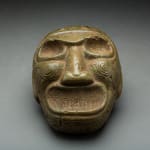Taino Stone Head, 1200 AD to 1500 AD
Stone
height 19.1 cm
height 7 1/2 in
height 7 1/2 in
PF.0211
Further images
The Taíno were an ethnic group of Arawak people, who were the indigenous people of the Caribbean. At the time of European contact in the late 15th century, the Taíno...
The Taíno were an ethnic group of Arawak people, who were the indigenous people of the Caribbean. At the time of European contact in the late 15th century, the Taíno were the principal inhabitants of most of Cuba, Jamaica, Hispaniola (Dominican Republic and Haiti), and Puerto Rico. Taíno spirituality centered on the worship of zemís, which are deities or ancestral spirits. Bones or skulls were often incorporated into sculptures of zemis. Zemis would also be consulted for advice and healing. During these consultation ceremonies, images of the zemi could be painted or tattooed on the body of priests. Zemis were generally sculpted from a wide variety of materials including bone, clay, wood, shell, sandstone and stone. They have been found in Cuba, Dominican Republic, Haiti, Jamaica, Puerto Rico, and other Caribbean islands. Some are quite large, up to 1 meter in height. Some could be effigies of birds, snakes, alligators and other animals, but mostly are human effigies. It is believed that the Taíno people hid their ceremonial objects in caves, away from the Spanish, or destroyed them as to avoid having them fall into Spanish hands.







